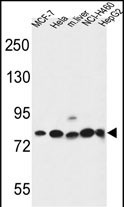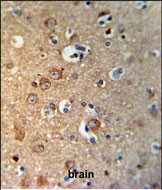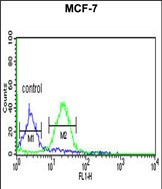GPHN Antibody (Center)
Affinity Purified Rabbit Polyclonal Antibody (Pab)
- 产品详情
- 实验流程
- 背景知识
Application
| WB, IHC-P, FC, E |
|---|---|
| Primary Accession | Q9NQX3 |
| Other Accession | Q03555, Q8BUV3, Q9PW38 |
| Reactivity | Human, Mouse |
| Predicted | Chicken, Rat |
| Host | Rabbit |
| Clonality | Polyclonal |
| Isotype | Rabbit IgG |
| Calculated MW | 79748 Da |
| Antigen Region | 437-466 aa |
| Gene ID | 10243 |
|---|---|
| Other Names | Gephyrin, Molybdopterin adenylyltransferase, MPT adenylyltransferase, Domain G, Molybdopterin molybdenumtransferase, MPT Mo-transferase, Domain E, GPHN, GPH, KIAA1385 |
| Target/Specificity | This GPHN antibody is generated from rabbits immunized with a KLH conjugated synthetic peptide between 437-466 amino acids from the Central region of human GPHN. |
| Dilution | WB~~1:1000 IHC-P~~1:100~500 FC~~1:10~50 E~~Use at an assay dependent concentration. |
| Format | Purified polyclonal antibody supplied in PBS with 0.09% (W/V) sodium azide. This antibody is purified through a protein A column, followed by peptide affinity purification. |
| Storage | Maintain refrigerated at 2-8°C for up to 2 weeks. For long term storage store at -20°C in small aliquots to prevent freeze-thaw cycles. |
| Precautions | GPHN Antibody (Center) is for research use only and not for use in diagnostic or therapeutic procedures. |
| Name | GPHN (HGNC:15465) |
|---|---|
| Synonyms | GPH, KIAA1385 |
| Function | Microtubule-associated protein involved in membrane protein- cytoskeleton interactions. It is thought to anchor the inhibitory glycine receptor (GLYR) to subsynaptic microtubules (By similarity). Acts as a major instructive molecule at inhibitory synapses, where it also clusters GABA type A receptors (PubMed:25025157, PubMed:26613940). |
| Cellular Location | Postsynaptic cell membrane; Lipid- anchor; Cytoplasmic side. Cell membrane {ECO:0000250|UniProtKB:Q03555}; Lipid-anchor {ECO:0000250|UniProtKB:Q03555}; Cytoplasmic side {ECO:0000250|UniProtKB:Q03555}. Cytoplasm, cytosol. Cytoplasm, cytoskeleton {ECO:0000250|UniProtKB:Q03555}. Cell projection, dendrite. Postsynaptic density {ECO:0000250|UniProtKB:Q8BUV3}. Note=Cytoplasmic face of glycinergic postsynaptic membranes (By similarity). Forms clusters at synapses (PubMed:25025157). {ECO:0000250|UniProtKB:Q03555, ECO:0000269|PubMed:25025157} |
For Research Use Only. Not For Use In Diagnostic Procedures.
Provided below are standard protocols that you may find useful for product applications.
BACKGROUND
GPHN encodes a neuronal assembly protein that anchors inhibitory neurotransmitter receptors to the postsynaptic cytoskeleton via high affinity binding to a receptor subunit domain and tubulin dimers. In nonneuronal tissues, the encoded protein is also required for molybdenum cofactor biosynthesis. Mutations in this gene may be associated with the neurological condition hyperplexia and also lead to molybdenum cofactor deficiency.
REFERENCES
Tabakoff, B., et al. BMC Biol. 7, 70 (2009)
Fritschy, J.M., et al. Trends Neurosci. 31(5):257-264(2008)
Inada, T., et al. Pharmacogenet. Genomics 18(4):317-323(2008)
Sugiyama, N., et al. Mol. Cell Proteomics 6(6):1103-1109(2007)
Ehrensperger, M.V., et al. Biophys. J. 92(10):3706-3718(2007)
Olsen, J.V., et al. Cell 127(3):635-648(2006)
终于等到您。ABCEPTA(百远生物)抗体产品。
点击下方“我要评价 ”按钮提交您的反馈信息,您的反馈和评价是我们最宝贵的财富之一,
我们将在1-3个工作日内处理您的反馈信息。
如有疑问,联系:0512-88856768 tech-china@abcepta.com.























 癌症的基本特征包括细胞增殖、血管生成、迁移、凋亡逃避机制和细胞永生等。找到癌症发生过程中这些通路的关键标记物和对应的抗体用于检测至关重要。
癌症的基本特征包括细胞增殖、血管生成、迁移、凋亡逃避机制和细胞永生等。找到癌症发生过程中这些通路的关键标记物和对应的抗体用于检测至关重要。 为您推荐一个泛素化位点预测神器——泛素化分析工具,可以为您的蛋白的泛素化位点作出预测和评分。
为您推荐一个泛素化位点预测神器——泛素化分析工具,可以为您的蛋白的泛素化位点作出预测和评分。 细胞自噬受体图形绘图工具为你的蛋白的细胞受体结合位点作出预测和评分,识别结合到自噬通路中的蛋白是非常重要的,便于让我们理解自噬在正常生理、病理过程中的作用,如发育、细胞分化、神经退化性疾病、压力条件下、感染和癌症。
细胞自噬受体图形绘图工具为你的蛋白的细胞受体结合位点作出预测和评分,识别结合到自噬通路中的蛋白是非常重要的,便于让我们理解自噬在正常生理、病理过程中的作用,如发育、细胞分化、神经退化性疾病、压力条件下、感染和癌症。








